Abstract
The ferroelectric (FE) to antiferroelectric (AFE) phase transition tuning the temperature range of electrocaloric (EC) effects was investigated using phenomenological Landau–Devonshire theory. Contrary to ferroelectric to paraelectric (PE) phase transitions for electrocaloric effects, the ferroelectric to antiferroelectric phase transition was adopted to obtain large entropy changes under an applied electric field in a Sm-doping BiFeO3 system. In addition, the doping composition and hydrostatic pressure was observed to tune the ferroelectricantiferroelectric–paraelectric phase transition temperatures and broaden the operating temperature range of electrocaloric effects. The optimal wide temperature range of ~78 K was observed at 3 GPa compressive hydrostatic pressures and 0.05 Sm-doping BiFeO3. The present study paves the way to designing high efficiency cooling devices with larger operating temperature spans.
1. Introduction
The electrocaloric (EC) effect has attracted great attention due to its potential to replace current domestic and industrial refrigeration systems to those based on solid-state cooling technology [1,2,3,4,5,6,7,8,9]. Usually, large EC effects in ceramics are reported within a narrow temperature range, sometimes even at a fixed temperature around the temperature of the ferroelectric (FE)–paraelectric (PE) phase transition above room temperature, which limits its applications. A wide operational temperature range near room temperature is highly desired in order to develop high performance EC cooling devices [10,11,12,13,14,15,16,17,18]. For instance, Sn4+ doping was reported to increase the operating temperature range of the EC effect in Ba0.9Sr0.1(Ti0.9Zr0.1)0.95Sn0.05O3 ceramics to 20 K [13]. The modified Ba(ZrxTi1−x)O3 ceramic generated a wide EC temperature change range at about 30 K [16] and 50 K in Y-substituted BaTiO3 ceramics [19]; even a temperature span from room temperature to 140 °C (~115 °C range) in BaTiO3 ceramics by rare-earth substitution was obtained [14]. According the results reported earlier, doping can vary the temperature range of different materials. Additionally, it has been demonstrated that the compressive or tensile strain induced by external stimuli (electric field, stress, pressure) can also remarkably change the spontaneous polarization of ferroelectrics, which influences the transition temperature range of the EC effect further [20,21,22,23].
Previous studies, in order to acquire a large adiabatic temperature change, mainly focused on the transition from the FE phase to the PE phase [24,25,26,27]. Later, the EC effect of the electric field-induced antiferroelectric (AFE) phase was proposed [15,28,29]. Lou et al. [30] reported that the phase transition from the AFE to the FE phase led to a giant EC effect in PbZrO3 thin films. Wang et al. [31] reported a large positive EC effect in a broad temperature range (~110 K) in Pb0.97La0.02(Zr0.65Sn0.3Ti0.05)O3 (PLZST) relaxor AFE thin films. Zhao et al. [11] reported the coexistence of giant negative and positive EC effects in Na0.5Bi4.5Ti4O15 (NBT) ferroelectric films over a broad temperature range. Surprisingly, the EC effect in NBT-based samples is caused by the FEAFE phase transition, which is different from previous FEPE and AFEFE phase transitions. The existence of the FEAFE phase transition in Sm-doping BiFeO3 (BFO) systems have been reported [32,33,34], however, the EC effect of the phase transition from FE to AFE in Sm-doping BFO ceramics has never been explored. BFO has a high leakage of current due to the existence of oxygen vacancies or defects, while a reduction in leakage current was observed with increases in Sm composition [35,36]. The breakdown of the electric field can be increased in Sm-doping BFO, hence the high entropy change also can be enhanced by chemical element doping. In this work, the existence of a giant electrocaloric response over a broad temperature range in the Sm-doping BFO system was investigated. The entropy change of different Sm-doping composition and hydrostatic pressure was calculated and discussed.
2. Theoretical Description
The theoretical model of describing an AFE phase is a simple two-sublattice model by Kittel [37]. Cross and Okada developed a phenomenological model using Gibbs free energy as a function of two dependent FE and AFE order parameters [38,39]. Xue et al. proposed a three-dimensional phenomenological model to successfully describe the temperature-, pressure-, and composition-induced ferroelectric to antiferroelectric phase transitions, which are consistent with the experimental phase diagrams [32]. Therefore, we adopted the same model and parameters to investigate the electrocaloric effects of Sm-doping BFO. To distinguish the FE and AFE phases, AFE and FE phases were divided into two sublattices, a and b, associated with polarization and respectively. If and are parallel to each other, the system exhibits the FE phase, as sketched in Figure 1a, otherwise, if and are antiparallel, it exhibits the AFE phase, as illustrated in Figure 1b. When and are both zero, it exhibits the PE phase.
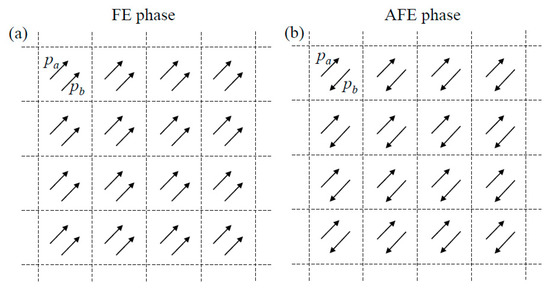
Figure 1.
Schematic of the (a) ferroelectric (FE) and (b) antiferroelectric (AFE) phases.
The FE and AFE order parameters, and , are defined as follows [40]:
In Equation (1), and were used instead of and to represent the AFE order parameter, because the polarization associated with sublattices of the AFE phase are sometimes different from that of the FE phase.
Taking the unpolarized and unstressed PE phase as the reference state, the total free energy density of the Sm-doping BFO system under an electric field can be expressed as [32]:
where and are the ith components of the FE and AFE order parameters; , , and , , are the FE and AFE dielectric stiffnesses, respectively. are coupling coefficients between the FE and AFE order parameters. are the elastic compliance constants; and are corresponding electrostrictive coefficients; σ is ith component of applied stress in Voigt notation; ε0 is the vacuum permittivity; Ei is the external applied electric field. Among all the coefficients, only and are assumed to be dependent on composition and temperature. All the coefficients used in this work are taken from reference [32].
The applied hydrostatic pressure tensors satisfy and . The EC effect was investigated based on indirect measurements using the Maxwell relation , where the total polarization P includes and . It is suggested that the reversible adiabatic change in entropy (∆S) can be calculated using the following relations [41]:
where Ea and Eb are the initial and final applied electric fields, respectively. is the density of BFO ceramics.
3. Results and Discussion
The total polarization (sum of the FE phase and AFE phase) as a function of temperature was calculated for different Sm compositions, shown in Figure 2a. It can be seen that the polarization of pure BFO indicates a first-order phase transition at 1100 K. As the composition of Sm in the BFO system increases, AFE phases are gradually observed. Meanwhile, the transition temperature decreases significantly with increasing Sm composition. As the Sm composition increases above 0.15 Sm-BFO, all the FE phase transforms to AFE phase. Similarly, hydrostatic pressure also can induce the AFE phase and decrease the transition temperature, as shown in Figure 2b. The temperature range of the FE phase decreases with hydrostatic pressure, and the FE phase disappears at a hydrostatic pressure higher than 5 GPa.
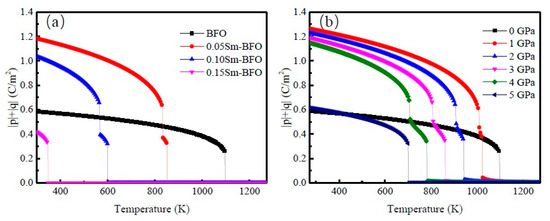
Figure 2.
The total polarization with (a) Sm compositions and (b) hydrostatic pressures as a function of temperature.
First, the temperature span of the EC effect at different Sm compositions was studied. The entropy changes of the EC effect in 0.05 Sm-BFO and 0.10 Sm-BFO were investigated, as shown in Figure 3. Figure 3a shows the entropy change as a function of temperature with different electric fields including 10, 20, 30 and 40 kV/cm. At 10 kV/cm, the entropy change has two peaks at 834 K and 853 K, which results from FE to AFE, and AFE to PE phase transitions, respectively. In addition, the entropy change also increases with the electric field. The large entropy changes ∆S of ~5 J/(kg·K) and ~4 J/(kg·K) were obtained in 0.05 Sm-BFO and 0.10 Sm-BFO at an electric field of 40 kV/cm. Remarkably, compared to previous works, we observed a large EC strength () in Sm-BFO. For example, BaTiO3 thick films exhibited a giant EC effect of ∆S = 10.1 J/(kg·K) at 800 kV/cm [42]. Therefore, the maximum EC strength in Sm-BFO can be obtained at 0.29 J·cm/(kg·K·kV), which is one order of magnitude larger than BaTiO3 thick films (0.013 J·cm/(kg·K·kV)). Furthermore, the temperature range of the entropy change in 0.10 Sm-BFO (~31 K) is wider than that in 0.05 Sm-BFO (~18 K), indicating that Sm-doping can broaden the temperature range of the EC effect.
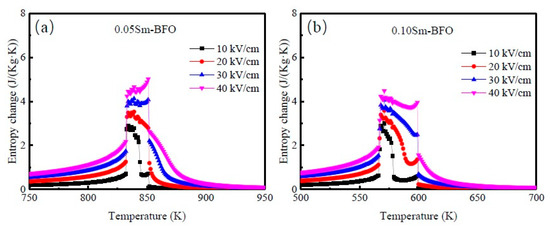
Figure 3.
Entropy changes of (a) 0.05 Sm-BFO (BiFeO3) and (b) 0.10 Sm-BFO as a function of temperature under different electric fields of 10, 20, 30, and 40 kV/cm.
In addition, the entropy changes of BFO as a function of temperature, at 0 GPa and 3 GPa, are shown in Figure 4. As shown in Figure 4a, the value of the entropy change increases with the increasing of the electric field, while only one peak of entropy change can be observed because only FEPE phase transition occurs. However, at 3 GPa hydrostatic pressure on pure BFO, there are two peaks of entropy change (Figure 4b). Since hydrostatic pressure can cause the appearance of the AFE phase, the FEAFEPE phase transition can broaden the temperature range of the EC effect. The AFE phase can be increased by increasing the hydrostatic pressure, and the temperature range (~64 K) becomes wider than that (~44 K) observed at 0 GPa hydrostatic pressure.
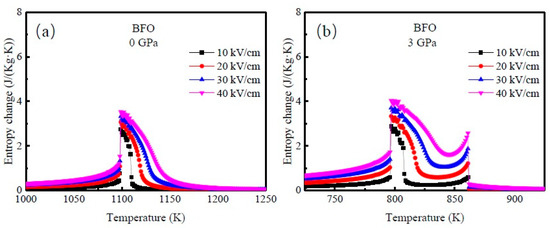
Figure 4.
Entropy changes of BFO with different electric fields as a function of temperature under (a) 0 GPa and (b) 3 GPa.
According to the above results, the Sm doping composition and hydrostatic pressure have a strong influence on the EC effect on temperature range and transition temperature. Therefore, we continued investigate the Sm doping composition and hydrostatic pressure to gain a broad temperature range under an ultralow electric field in Figure 5. As shown in Figure 5a, there are two peaks of entropy change, and the value of the entropy change increases with an increasing of the electric field. The transition temperature range of 0.05 Sm-BFO can be broadened by applying 3 GPa of hydrostatic pressure. The temperature range of 0.05 Sm-BFO at 3 GPa is about 78 K, which is wider than that at zero hydrostatic pressure (~18 K), as shown in Figure 3a. Similarly, the two peaks in entropy changes of 0.10 Sm-BFO at 0.5 GPa indicate that FEAFEPE phase transitions occurred (Figure 5b). The temperature range of 0.01 Sm-BFO at 0.5 GPa (~42 K) is also wider than that at zero hydrostatic pressure (~31 K), as shown in Figure 3b. Meanwhile, the transition temperature range of 0.10 Sm-BFO at 0.5 GPa can be broadened by choosing an optimal chemical doping and hydrostatic pressure.
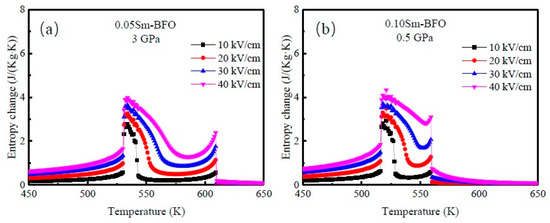
Figure 5.
Entropy changes of (a) 0.05 Sm-BFO with different electric fields as a function of temperature under 3 GPa and (b) 0.10 Sm-BFO with different electric fields as a function of temperature under 0.5 GPa.
4. Conclusions
In summary, the ferroelectric to antiferroelectric phase transition tuning of the temperature range of electrocaloric effects was investigated using the phenomenological LandauDevonshire theory. The results show that both the doping composition and hydrostatic pressure can induce the AFE phase. A large entropy change during the FEAFEPE phase transition process can be obtained at 40 kV/cm. Meanwhile, hydrostatic pressure and Sm-doping can broaden the operating temperature range and adjust the ferroelectricantiferroelectricparaelectric phase transition temperature to room temperature, which paves the way in designing high efficiency cooling devices near room temperature.
Author Contributions
X.S. and H.H. carried out the concepts, design, definition of intellectual content, literature search, data acquisition, data analysis and manuscript preparation. H.M.J. carried out manuscript editing. J.W., Y.W. and Z.-M.D. performed manuscript review. All authors have read and approved the content of the manuscript.
Funding
This research was funded by [the National Natural Science Foundation of China] grant number [11504020].
Acknowledgments
This work was sponsored by the National Natural Science Foundation of China (11504020). The authors are grateful to the discussion with Fei Xue, who worked on the phase field model in Pennsylvania State University.
Conflicts of Interest
The authors declare no conflict of interest.
References
- Zhang, G.; Li, Q.; Gu, H.; Jiang, S.; Han, K.; Gadinski, M.R.; Haque, M.A.; Zhang, Q.; Wang, Q. Ferroelectric polymer nanocomposites for room-temperature electrocaloric refrigeration. Adv. Mater. 2015, 27, 1450–1454. [Google Scholar] [CrossRef]
- Guo, L.S.; Zhang, Q.M. Electrocaloric Materials for Solid-State Refrigeration. Adv. Mater. 2009, 21, 1983–1987. [Google Scholar]
- Quintero, M.; Ghivelder, L.; Gomez-Marlasca, F.; Parisi, F. Decoupling electrocaloric effect from Joule heating in a solid state cooling device. Appl. Phys. Lett. 2011, 99, 232908. [Google Scholar] [CrossRef]
- Chukka, R.; Cheah, J.; Chen, Z.; Yang, P.; Shannigrahi, S.; Wang, J.; Chen, L. Enhanced cooling capacities of ferroelectric materials at morphotropic phase boundaries. Appl. Phys. Lett. 2011, 98, 242902. [Google Scholar] [CrossRef]
- Karmanenko, S.F.; Pakhomov, O.V.; Prudan, A.M.; Starkov, A.S.; Eskov, A. Layered ceramic structure based on the electrocaloric elements working as a solid state cooling line. J. Eur. Ceram. Soc. 2007, 27, 3109–3112. [Google Scholar] [CrossRef]
- Ožbolt, M.; Kitanovski, A.; Tušek, J.; Poredoš, A. Electrocaloric refrigeration: Thermodynamics, state of the art and future perspectives. Int. J. Refrig. 2014, 40, 174–188. [Google Scholar] [CrossRef]
- Correia, T.M.; Kar-Narayan, S.; Young, J.S.; Scott, J.F.; Mathur, N.D.; Whatmore, R.W.; Zhang, Q. PST thin films for electrocaloric coolers. J. Phys. D Appl. Phys. 2011, 44, 165407. [Google Scholar] [CrossRef]
- Lu, S.G.; Rožič, B.; Zhang, Q.M.; Kutnjak, Z.; Pirc, R.; Lin, M.; YLi, X.; Lee, G. Comparison of directly and indirectly measured electrocaloric effect in relaxor ferroelectric polymers. Appl. Phys. Lett. 2010, 97, 202901. [Google Scholar] [CrossRef]
- Khodayari, A.; Mohammadi, S. Solid-State Cooling Line Based on the Electrocaloric Effect. IEEE Trans. Ultrason. Ferroelectr. Freq. Control 2011, 58, 503–508. [Google Scholar] [CrossRef]
- Li, Q.; Zhang, G.; Zhang, X.; Jiang, S.; Zeng, Y.; Wang, Q. Relaxor ferroelectric-based electrocaloric polymer nanocomposites with a broad operating temperature range and high cooling energy. Adv. Mater. 2015, 27, 2236–2241. [Google Scholar] [CrossRef] [PubMed]
- Chen, J.; Tang, Z.; Zhao, S. Giant Negative and Positive Electrocaloric Effects Coexisting in Lead-Free Na0.5Bi4.5Ti4O15 Films Over a Broad Temperature Range. Phys. Status. Solidi RRL 2018, 12, 1700443. [Google Scholar] [CrossRef]
- Chen, J.; Tang, Z.; Lu, Q.; Zhao, S. Giant negative electrocaloric effect over a broad temperature range in lead-free based Bi0.5(K0.15Na0.85)0.05TiO3 relaxor ferroelectric films. J. Alloy. Compd. 2018, 756, 62–67. [Google Scholar] [CrossRef]
- Li, T.; Liu, X.; Shi, S.; Yin, Y.; Li, H.; Wang, Q.; Zhang, Y.; Bian, J.; Rajput, S.S.; Long, C.; et al. Large electrocaloric efficiency over a broad temperature span in lead-free BaTiO3-based ceramics near room temperature. Appl. Phys. Lett. 2017, 111, 202902. [Google Scholar] [CrossRef]
- Han, F.; Bai, Y.; Qiao, L.J.; Guo, D. A systematic modification of the large electrocaloric effect within a broad temperature range in rare-earth doped BaTiO3 ceramics. J. Mater. Chem. C 2016, 4, 1842–1849. [Google Scholar] [CrossRef]
- Geng, W.P.; Liu, Y.; Meng, X.J.; Bellaiche, L.; Scott, J.F.; Dkhil, B.; Jiang, A. Giant Negative Electrocaloric Effect in Antiferroelectric La-Doped Pb(ZrTi)O3 Thin Films Near Room Temperature. Adv. Mater. 2015, 27, 3165–3169. [Google Scholar] [CrossRef] [PubMed]
- Qian, X.; Ye, H.; Zhang, Y.; Gu, H.; Li, X.; Randall, C.A.; Zhang, Q.M. Giant Electrocaloric Response Over A Broad Temperature Range in Modified BaTiO3 Ceramics. Adv. Funct. Mater. 2014, 24, 1300–1305. [Google Scholar] [CrossRef]
- Cao, W.P.; Li, W.L.; Dai, X.F.; Zhang, T.D.; Sheng, J.; Hou, Y.F.; Fei, W.D. Large electrocaloric response and high energy-storage properties over a broad temperature range in lead-free NBT-ST ceramics. J. Eur. Ceram. Soc. 2016, 36, 593–600. [Google Scholar] [CrossRef]
- Sun, X.; Huang, H.; Ma, X.; Wen, Y.; Dang, Z.M. Tunable Temperature Range of Stress-Enhanced Electrocaloric Effects in Composition Gradient Bilayers. J. Ceram. Sci. Technol. 2018, 9, 201–208. [Google Scholar]
- Zhao, Y.; Liu, X.Q.; Wu, J.W.; Wu, S.Y.; Chen, X.M. Electrocaloric effect in relaxor ferroelectric Ba(Ti1-xYx)O3-x/2 ceramics over a broad temperature range. J. Alloy. Compd. 2017, 729, 57–63. [Google Scholar] [CrossRef]
- Zhang, X.; Wang, J.B.; Li, B.; Zhong, X.L.; Lou, X.J.; Zhou, Y.C. Sizable electrocaloric effect in a wide temperature range tuned by tensile misfit strain in BaTiO3 thin films. J. Appl. Phys. 2011, 109, 126102. [Google Scholar] [CrossRef]
- Zhang, J.X.; Li, Y.L.; Wang, Y.; Liu, Z.K.; Chen, L.Q.; Chu, Y.H.; Zavaliche, F.; Ramesh, R. Effect of substrate-induced strains on the spontaneous polarization of epitaxial BiFeO3 thin films. J. Appl. Phys. 2007, 101, 114105. [Google Scholar] [CrossRef]
- Sun, X.; Huang, H.; Wang, J.; Wen, Y.; Dang, Z.-M. Strain-induced broadening temperature range of electrocaloric effects in ferroelectric superlattices. J. Alloy. Compd. 2019, 777, 821–827. [Google Scholar] [CrossRef]
- Huang, H.; Zhang, G.; Ma, X.; Liang, D.; Wang, J.; Liu, Y.; Wang, Q.; Chen, L.-Q. Size effects of electrocaloric cooling in ferroelectric nanowires. J. Am. Ceram. Soc. 2018, 101, 1566–1575. [Google Scholar] [CrossRef]
- Zhang, G.; Zhang, X.; Huang, H.; Wang, J.; Li, Q.; Chen, L.Q.; Wang, Q. Toward Wearable Cooling Devices: Highly Flexible Electrocaloric Ba0.67Sr0.33TiO3 Nanowire Arrays. Adv. Mater. 2016, 28, 4811–4816. [Google Scholar] [CrossRef] [PubMed]
- Mischenko, A.S.; Zhang, Q.; Scott, J.F.; Whatmore, R.W.; Mathur, N.D. Giant electrocaloric effect in thin-film PbZr0.95Ti0.05O3. Science 2006, 311, 1270–1271. [Google Scholar]
- Neese, B.; Chu, B.J.; Lu, S.G.; Wang, Y.; Furman, E.; Zhang, Q.M. Large Electrocaloric Effect in Ferroelectric Polymers Near Room Temperature. Science 2008, 321, 821–823. [Google Scholar] [CrossRef]
- Saranya, D.; Chaudhuri, A.R.; Parui, J.; Krupanidhi, S.B. Electrocaloric effect of PMN–PT thin films near morphotropic phase boundary. Bull. Mater. Sci. 2009, 32, 259–262. [Google Scholar] [CrossRef]
- Zheng, G.P.; Uddin, S.; Zheng, X.C.; Yang, J.H. Structural and electrocaloric properties of multiferroic-BiFeO3 doped 0.94Bi0.5Na0.5TiO3-0.06BaTiO3 solid solutions. J. Alloy. Compd. 2016, 663, 249–255. [Google Scholar] [CrossRef]
- Peng, B.L.; Fan, H.Q.; Zhang, Q. A Giant Electrocaloric Effect in Nanoscale Antiferroelectric and Ferroelectric Phases Coexisting in a Relaxor Pb0.8Ba0.2ZrO3 Thin Film at Room Temperature. Adv. Funct. Mater. 2013, 23, 2987–2992. [Google Scholar] [CrossRef]
- Wu, M.; Song, D.; Vats, G.; Ning, S.; Guo, M.; Zhang, D.; Xue, D.; Pennycook, S.J.; Lou, X. Defect-controlled electrocaloric effect in PbZrO3 thin films. J. Mater. Chem. C 2018, 6, 10332–10340. [Google Scholar] [CrossRef]
- Peng, B.; Zhang, Q.; Lyu, Y.; Liu, L.; Lou, X.; Shaw, C.; Huang, H.; Wang, Z. Thermal strain induced large electrocaloric effect of relaxor thin film on LaNiO3/Pt composite electrode with the coexistence of nanoscale antiferroelectric and ferroelectric phases in a broad temperature range. Nano Energy 2018, 47, 285–293. [Google Scholar] [CrossRef]
- Xue, F.; Liang, L.; Gu, Y.; Takeuchi, I.; Kalinin, S.V.; Chen, L.Q. Composition- and pressure-induced ferroelectric to antiferroelectric phase transitions in Sm-doped BiFeO3 system. Appl. Phys. Lett. 2015, 106, 012903. [Google Scholar] [CrossRef]
- Liao, Z.; Xue, F.; Sun, W.; Song, D.; Zhang, Q.; Li, J.-F.; Chen, L.-Q.; Zhu, J. Reversible phase transition induced large piezoelectric response in Sm-doped BiFeO3 with a composition near the morphotropic phase boundary. Phys. Rev. B 2017, 95, 214101. [Google Scholar] [CrossRef]
- Cheng, C.J.; Kan, D.; Lim, S.H.; McKenzie, W.R.; Munroe, P.R.; Salamanca-Riba, L.G.; Withers, R.L.; Takeuchi, I.; Nagarajan, V. Structural transitions and complex domain structures across a ferroelectric-to-antiferroelectric phase boundary in epitaxial Sm-doped BiFeO3 thin films. Phys. Rev. B 2009, 80, 014109. [Google Scholar] [CrossRef]
- Marzouki, A.; Harzali, H.; Loyau, V.; Gemeiner, P.; Zehani, K.; Dkhil, B.; Bessais, L.; Megriche, A. Large magnetoelectric response and its origin in bulk Co-doped BiFeO3 synthesized by a stirred hydrothermal process. Acta Mater. 2018, 145, 316–321. [Google Scholar] [CrossRef]
- Dai, H.; Chen, Z.; Li, T.; Li, Y. Microstructure and properties of Sm-substituted BiFeO3 ceramics. J. Rare Earths 2012, 30, 1123–1128. [Google Scholar] [CrossRef]
- Kittel, C. Theory of Antiferroelectric Crystals. Phys. Rev. 1951, 82, 729–732. [Google Scholar] [CrossRef]
- Okada, K. Phenomenological Theory of Antiferroelectric Transition I. Second-Order Transition. J. Phys. Soc. Jpn. 1969, 27, 420–428. [Google Scholar] [CrossRef]
- Cross, L.E. Antiferroelectric-Ferroelectric Switching in a Simple "Kittel" Antiferroelectric. J. Phys. Soc. Jpn. 1967, 23, 77–82. [Google Scholar] [CrossRef]
- Rabe, K.M. Functional Metal Oxides: New Science and Novel Applications; Wiley-VCH Verlag GmbH & Co. KGaA: Weinheim, Germany, 2013; p. 221. [Google Scholar]
- Lines, M.E.; Glass, A.M. Principles and Applications of Ferroelectrics and Related Materials; Clarendon Press: Oxford, UK, 1977. [Google Scholar]
- Bai, Y.; Zheng, G.P.; Ding, K.; Qiao, L.J.; Shi, S.Q.; Guo, D. The giant electrocaloric effect and high effective cooling power near room temperature for BaTiO3 thick film. J. Appl. Phys. 2011, 110, 094103. [Google Scholar]
© 2019 by the authors. Licensee MDPI, Basel, Switzerland. This article is an open access article distributed under the terms and conditions of the Creative Commons Attribution (CC BY) license (http://creativecommons.org/licenses/by/4.0/).